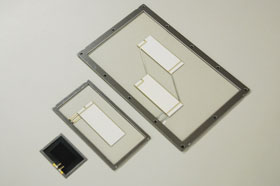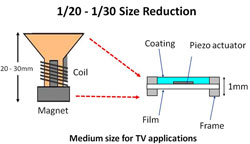Super-thin Speakers in LG's Curved OLED TV Explained
The super-thin speakers used in LG's Curved OLED TV is Kyocera's Smart Sonic Sound tech.

We first drooled over LG's 55 inch curved OLED TV during CES 2013 back in January. Besides being a gorgeous curved OLED display, the TV also has an edge thickness of just 4.3 mm. That's extremely thin if you think about it, which leads to the question: just how thin are the integrated speakers?
Kyocera reveals in LG's curvy OLED TV is Smart Sonic Sound, a new audio product that utilizes a piezoelectric actuator combined with a special film to create a piezo film speaker. This new speaker tech comes in three sizes: Large measuring 1.5 mm thin, Medium at 1 mm thin, and Small measuring at 0.7 mm thin. The tech not only yields thinner devices like HDTVs, smartphones and tablets, but supposedly enhances audio quality for a more realistic audio experience.
MORE: Cord Cutting Dilemma: Should You Keep Cable TV?
"The piezo actuator used in the new product was born from Kyocera’s proprietary fine ceramic material technology and lamination technology, combined with a special film," the company explains. "Smart Sonic Sound can create the same audio volume as conventional electromagnetic speakers in just a fraction of the width and weight. This allows for the speaker device to be built onto the front face of an end-product with ease ― contributing to flexibility and enhancements in end-product designs."

Kyocera says that the directional projection of sound waves, or directivity, is more balanced than a conventional speaker as the piezo actuator and film create sound through vibrations. This means that sound quality and volume are actually delivered at near equal levels within a 180 degree range. That said, Smart Sonic Sound is supposedly capable of reproducing delicate and minute sounds with greater clarity such a raindrops and background effects.
"Electromagnetic speakers use the repulsion force of magnetic fields created between the magnet and coil to produce sound, which is achieved through the use of rare earth elements such as neodymium," the company explains. "Conversely, the core component in the Smart Sonic Sound is made of a piezo actuator (fine ceramics) and resins, so the new product eliminates the use of rare earths."
Smart Sonic Sound is actually the second "Smart Sonic" product released by Kyocera. The company introduced Smart Sonic Receiver back in 2012 for smartphones sold in Japanese and North American markets. This tech uses a ceramic actuator to send vibrations via tissue conduction and traditional air conduction through display screens without the need for a traditional earpiece or loudspeaker. The new Smart Sonic Sound uses the same base technology, but with a different method to amplify air conduction.
Sign up to get the BEST of Tom's Guide direct to your inbox.
Get instant access to breaking news, the hottest reviews, great deals and helpful tips.
"The new product is based on the company’s long history of pioneering fine ceramic technology and utilizes a piezoelectric actuator combined with a special film to create a piezo film speaker," the company states. "Its low directivity characteristics broaden the sound projection range, providing 180-degree sound quality and bringing delicate and minute sounds to life."
The Large Smart Sonic Sound speaker measures 70 x 110 x 1.5 mm, weighs 23g, and has a frequency range of 200 Hz to 20 kHz. The Medium model measures 35 x 65 x 1.0 mm, weighs 7g, and has a frequency range of 500 Hz to 20 kHz. The Small version measures just 19.6 x 27.5 x 0.7 mm, weighs 1g, and has a frequency of 600 Hz to 20 kHz.
- Marvell, Lenovo Collaborate on Flagship Android Smart TVs
- LG Makes Old New Again with Retro-styled HDTV Set
- Improve Your HDTV Picture Quality in 4 Easy Steps
Follow us @tomsguide, on Facebook and on Google+.
Kevin started taking PCs apart in the 90s when Quake was on the way and his PC lacked the required components. Since then, he’s loved all things PC-related and cool gadgets ranging from the New Nintendo 3DS to Android tablets. He is currently a contributor at Digital Trends, writing about everything from computers to how-to content on Windows and Macs to reviews of the latest laptops from HP, Dell, Lenovo, and more.
-
dmitche3 Like so many crappy articles on audio... you mention that it can produce a frequency range of 200 Hz to 20kHz. Does anyone ever remember seeing a frequency graph? 99% of the cheap crap out there can claim that they cover this range. The problem is at what point do frequency characters change? How well does it handle a low bass while at the same time producing a true quality 14kHz? It has been years since I've seen anyone do truly scientific test and compare audio speakers and equipment, and Tom's is just as ignorant as all the others.Reply -
ubercake Most people in the market for curved OLED tellies don't care about the speakers. They have a separate receiver for audio.Reply
For high-end customers, unless these companies can somehow create a surround system emitted by the television without the necessity of having speakers in the appropriate positions, they should focus on the visual and audio as separate components. -
milktea I'm guessing that these piezos are the cheaper alternative to the electrostatic speakers?Reply -
mcd023 I think these are pretty cool actually. And yes, I am aware that you get a dedicated system for good sound, but I still think this is cool tech.Reply -
3ogdy Like so many crappy articles on audio... you mention that it can produce a frequency range of 200 Hz to 20kHz. Does anyone ever remember seeing a frequency graph? 99% of the cheap crap out there can claim that they cover this range. The problem is at what point do frequency characters change? How well does it handle a low bass while at the same time producing a true quality 14kHz? It has been years since I've seen anyone do truly scientific test and compare audio speakers and equipment, and Tom's is just as ignorant as all the others.Reply
The thing is...what's the point of asking about bass when the 30Hz are not even included in the frequency range?
Weren't subwoofers supposed to touch the 30Hz+ area in order for a sound to be perceived as "deep bass"?
-
gm0n3y While the tech is pretty cool and it's great that they are making TVs thinner, considering that the majority of people buying a mid-upper range TV will have a separate speaker system, this is kind of pointless.Reply -
warezme These will not have any bass. Low frequency dynamic audio requires the forceful movement of large amounts of air in the low frequency range. The design of these thin speakers limits the range of motion and power capabilities. So while they will be great at delicate minute sounds at wider dispersion, don't expect any bass out of these, at all.Reply -
makkem This is not new technology Piezo tweeters have been available for years,and with those frequency response figures these should be regarded as tweeters .Reply -
virgult I appreciate that most of the comments here are of people disgusted by the specs and performance of the speakers (this is the only sane reaction, period), but on the other hand I don't see any differences in performance between these piezo speakers and the cheapo drivers used so far. It's a reasonable innovation, for the sake of making the TV thinner, but since the goal here was in no way related to audio, and the performance to compare it with was terrible to start with, I don't see why we should discuss about its audio performance! :)Reply -
virgult I appreciate that most of the comments here are of people disgusted by the specs and performance of the speakers (this is the only sane reaction, period), but on the other hand I don't see any differences in performance between these piezo speakers and the cheapo drivers used so far. It's a reasonable innovation, for the sake of making the TV thinner, but since the goal here was in no way related to audio, and the performance to compare it with was terrible to start with, I don't see why we should discuss about its audio performance! :)Reply
